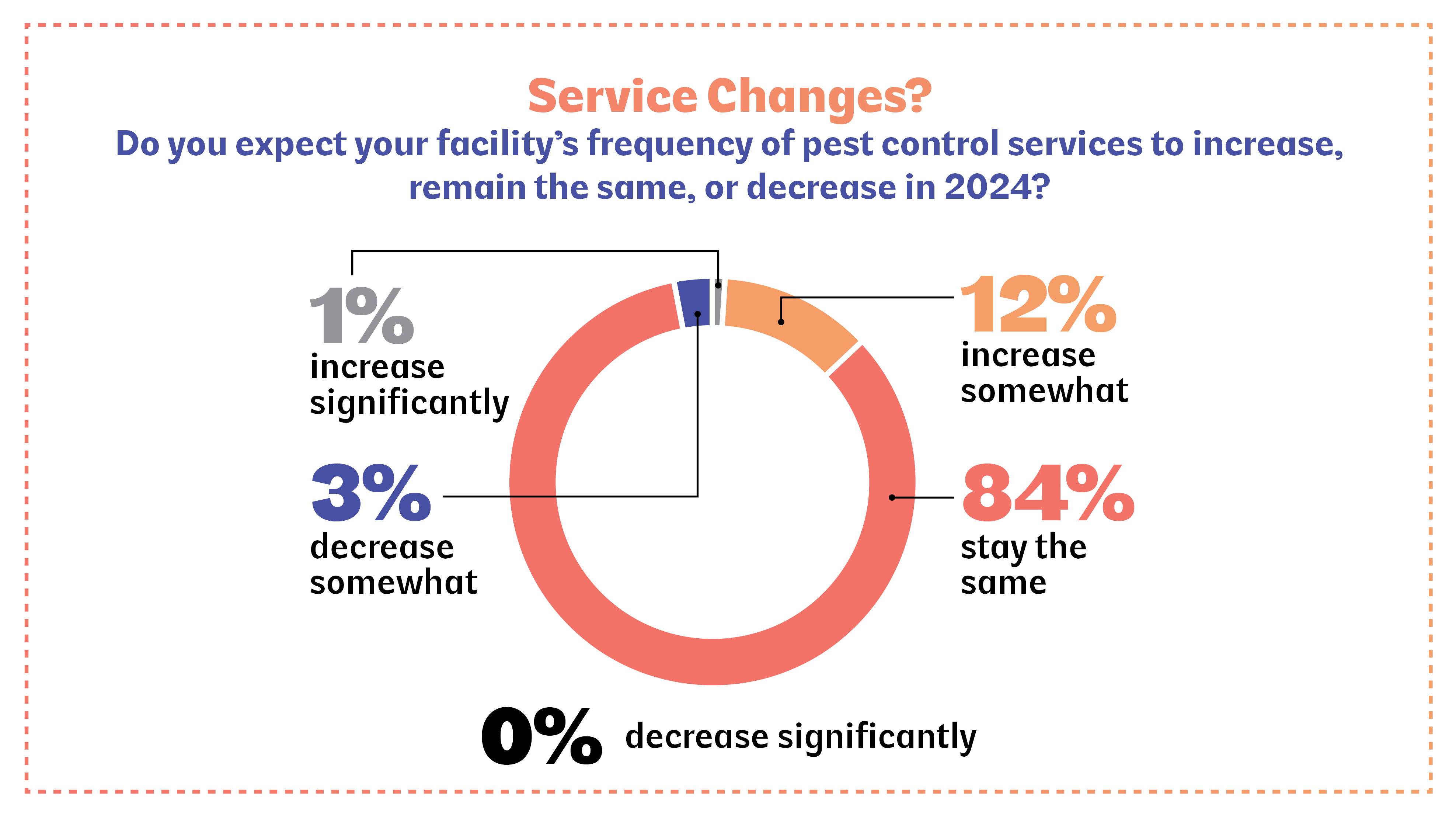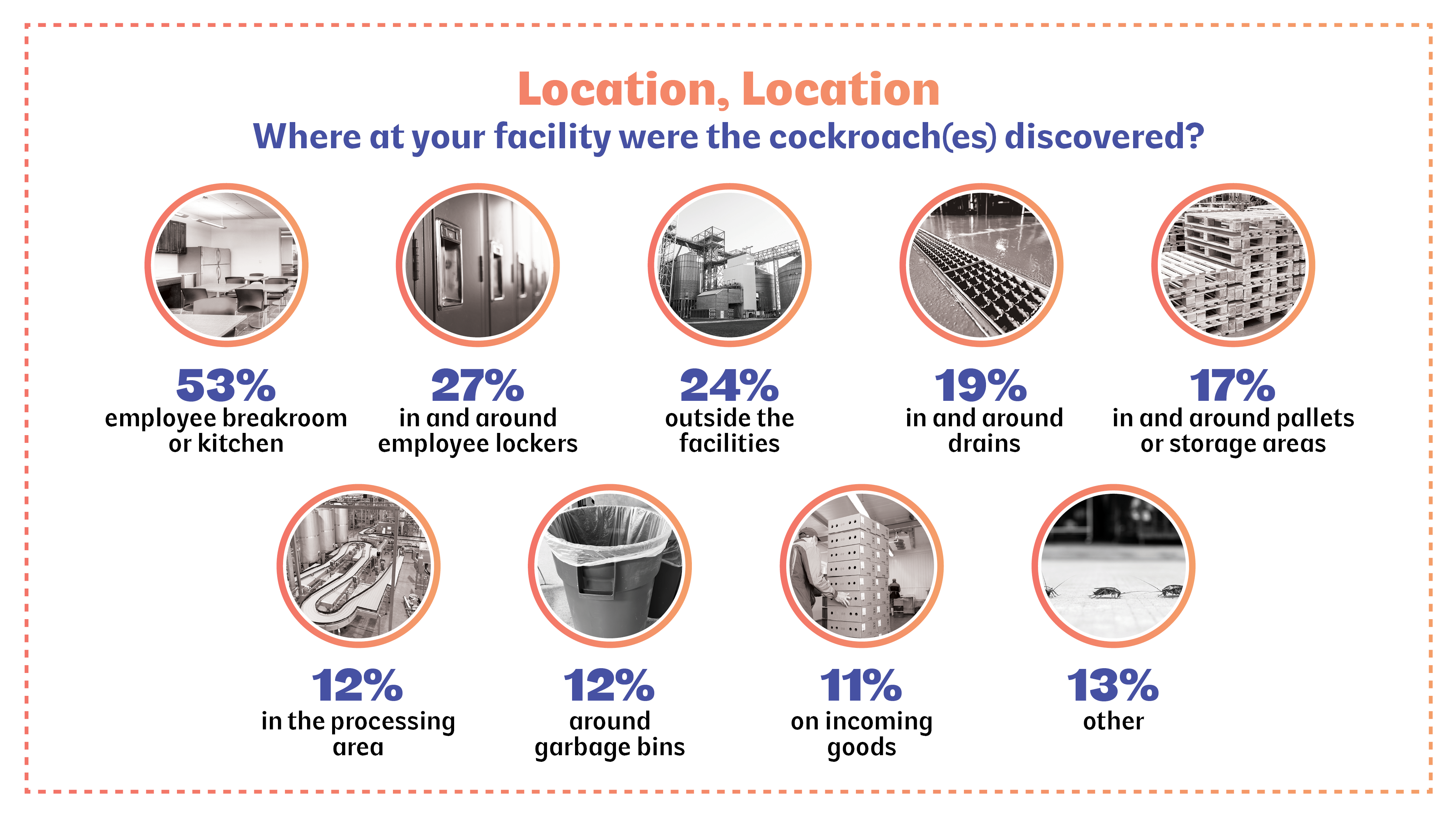Cockroaches can spread at least 33 kinds of bacteria, six types of parasitic worms and more than seven kinds of human pathogens, making them nasty guests at any food or beverage processing facility. “They are considered extremely unsanitary,” said Sydney Crawley, principal vector scientist, Rentokil-Terminix.
Aside from the sheer number of disease risks Crawley shared, they travel through unsavory pathways such as through sewage and debris, bringing the yuck along with them to areas in a facility that are vulnerable to product contamination.
Who wants to even think about a cockroach leaving behind pathogenic footsteps, let alone witness it? Or, worse, what happens when word gets out to consumers?
“Food plants are very complicated, and pest control overlaps with so many aspects of operations,” said Chelle Hartzer, B.C.E., PCQI, 360 Pest Consulting. “It overlaps with sanitation, facility maintenance, inspections and the building infrastructure.”
The good news is, 99% of respondents to Quality Assurance and Food Safety magazine’s State of the Cockroach Control Market survey, sponsored by Zoëcon, conduct pest control at their food/beverage facilitiesand 99% say their cockroach control programs have been successful. On the other hand, 50% report sighting a cockroach (or many), and while 38% cited the pest as a “great concern,” cockroaches ranked lower than mice, flies, rats and stored product pests.
That’s not what pest control pros think about cockroaches, which they regard as public enemy No. 1 or No. 2.
“Certain types of flies are similarly efficient mechanical vectors, but the stigma associated with cockroaches probably ranks them as the worst insect pest in food processing,” Crawley said.

“The German cockroach lifecycle is just so fast, before you know it, a problem can get out of control,” said Greg Bausch, A.C.E., vice president, American City Pest & Termite.
That said, proactive, persistent pest management can protect a facility from reputational damage, costly recalls, audit citations and loss of business.
ID AND CONQUER. They hitch a ride with employees, are delivered by way of semitruck to loading docks and burrow away in storage spaces. They creep into employee lunchrooms and lockers and duck into the slim voids of stacked cans. Any type of equipment is a go-to harborage, as are joints and junctions on walls and ceilings.
“Suspended ceilings are an area of concern,” said Patricia Hottel, technical manager, Rentokil-Terminix, adding recyclables returned to facilities as another vehicle of entry. Drains are often overlooked and ripe for roach roosting.
HVAC systems that hold moisture and vending machines with running motors that generate a warm environment are additional cockroach hideouts, Hartzer said. “Those machines never get moved, and every time the floor is washed, it pushes debris underneath — cockroach heaven.”
American and Oriental cockroaches are known to enter buildings on a regular basis, said Dini Miller, professor of urban pest management at Virginia Tech University. “It tends to be seasonal — they’re coming indoors because it’s cold or they can’t find food.”
In general, pests are crossing borders more readily with environmental shifts that extend the “busy season.”
“Climate change is affecting many of our pest populations, so be aware of that and recognize that some species of cockroaches that have not been an issue could be in your future,” Hartzer said.
These days, cockroaches “aren’t that picky” regarding where they’ll eat, breed and poop. In fact, the feces factor is a warning sign, Miller said. “Feces tells cockroaches that others have been there and it’s a good place to hang out,” she said.
Pest professionals and facility managers should keep an eye on all of these critical inspection points.
“Food processors along with their pest management companies should perform a proper risk assessment, and based on this, monitoring and control methods are implemented,” said Hottel.

Hottel also recommends maintaining logbooks so employees can record sightings in the moment.
Ultimately, every team member in a facility can be an inspection asset if given the tools. The more eyes, the better. “Hold training sessions and talk about employees’ roles in preventing pests,” Hottel said.
MAP, TRAP & MONITOR. A multi-layered approach and regularly evaluating a cockroach management program’s performance contributes to control success. So does consistency. Slightly more than half of QA survey respondents said cockroach control products are applied “as needed,” while 27% maintain a monthly program and 14% opt for more frequent applications.
The intensity of a program depends on monitoring results.
Miller subscribes to monthly sticky trap placement and assigning a point person to rigorously record sightings. “Map those trap locations,” she said.
In conjunction with a log, these tools help inform a pest management program.
Bausch begins a cockroach control regimen with the industry-standard inspection and monitoring, followed by targeted applications where needed. “Then we identify structural issues and continue monitoring,” he said, adding that baits should be rotated several times annually to prevent aversion. Sanitation protocols are also essential.
Prolonged monitoring is an essential element of any Integrated Pest Management (IPM) program, Crawley said. “Record trends and collect usable data,” she said. “Tracking data occasionally is not helpful.”
This role can be delegated to a pest management professional (PMP).
“At least once a year, the program should be reviewed to determine if changes are advised,” Hottel said. “This review should also include a discussion of new techniques and improved strategies for implementation.”
Timing matters.
“During the summer, the cockroach population can double, triple and quadruple,” said Miller. “If we go in during the winter and hit them hard with baits, we can eliminate infestations and they do not rebound during summer.”
Explaining why cockroach and pest monitoring, in general, is an always-on affair, Miller says dormant issues still deserve monthly to quarterly service at least. Active cockroach problems can require bi-weekly service or more.
Also, request metrics from your pest provider.
“You need records that show the program is actually reducing the pest population,” Miller said. “I see a lot of treating with no data, and you need documentation that your efforts are actually working.”
Get curated news on YOUR industry.
Enter your email to receive our newsletters.
Explore the March/April 2024 Issue
Check out more from this issue and find your next story to read.
Latest from Quality Assurance & Food Safety
- Q&A: Sandra Eskin Leads Food Safety Advocacy Organization, STOP, as CEO
- STOP CEO Eskin on Government Layoffs, Challenges in Food Safety
- Mission Barns Announces Cell-Cultivated Pork Fat Launch Following FDA Clearance
- Hearthside Food Solutions Recalls Breakfast Sandwiches Due to Undeclared Allergen
- Walker’s Wine Juice Recalls Pumpkin Juice Due to Botulism Risk
- The Cascading Food Safety Impacts of Tariffs on the Food Industry
- Tyson Ventures Calls Startups to Apply for Tyson Demo Day
- Student Finalists Selected for IFT Product Development Competitions






